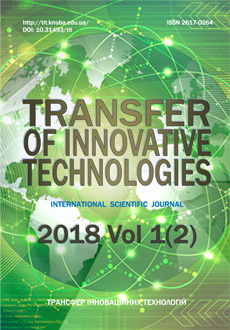Physiological model of one materialized human thought
DOI:
https://doi.org/10.31493/tit1812.0304Keywords:
Axiomatic modeling, artificial intelligence, mathematical logic, thinking, formalizationAbstract
In this article, the creation in the second signal system of a correct reflex ring – physiological model of one of the materialized elementary, or compound human thoughts – is shown on a specific example. As tools, functionally full formal language and predicate logic language are used. The methodology is described in the Theory of axiomatic modeling of Kondratenko [1]. As any other functional problem in any domain, according to the Theory, the problem is interpreted in mathematical logic as a theorem which is subject to proof. The reflex ring is physiological model of one of materialized elementary, or compound, thoughts of the specific person, as the ring represents a fragment of neural network of the person. The logical work of concepts of knowledge reflected in concepts No.1 – 7, is guaranteed to provide the creation of the correct reflex ring having the property of "being physiological model of one of the materialized elementary, or compound thoughts of a person". At reflection on visual carriers of any concrete functionally complete sense received in the course of knowledge of the natural and man-made phenomena of the universe, only purely formulary texts are an ideal format in terms of quantity of the symbols necessary for these purposes. Even the axiomatic format of reflection of the specified meanings demands one-two orders more of symbols, not to mention a verbal format from which the order of magnitude of formulary symbols can exceed four in certain cases. Special importance is gained by this fact at reflection on visual carriers of biological and medical knowledge.References
Kondratenko V.A., 2010. Creation of a uniform stereotype of a logical design of thinking for the substantial and formal proof of theorems. Kiev Scientific publication of Alephof, 267 (in Russian).
Nilsson N.J., 1982. Principles of artificial intelligence, Springer-Verlag Berlin Heidelberg, 476.
Russell S., Norvig P., 2009. Artificial intelligence: a modern approach, 3rd ed. Prentice Hall, 1152.
Turing A., 1950. Computing Machinery and Intelligence. Mind, Vol.59, No. 236, 433–460.
Anokhin P.K., 1998. Chosen works. Cybernetics of functional systems. Moscow, Medicine, 400 (in Russian).
Nazarenko O., 2018. Modeling the reliability of the recycled water supply system at global warming conditions. Transfer of Innovative Technologies, Vol.1(1), 50-57 (in Ukrainian).
Otradnov K, Volodymyr Shuliak, Sergii Kornieiev, 2017. Underwater wireless video communication in operations of AUV/UUVs – new horizon of underwater explorations. Underwater Technologies, Vol.06, 46-56 (in Russian).
Bezverkhy O, 2016. Oscillations buoy-moored barrier systems on the waves. Underwater Technologies, Vol.03, 14-24 (in Ukrainian).
Kondratenko V.A., 2016. Creation of formal model of standard dialectic logic of automatic control of the anatomo-functional systems of a human body. The 5th International scientific and technical conference Information Systems and Technologies Kharkiv-Koblevo IST-2016 (on September 12-17, 2016), (in Russian).
Kondratenko V.A., 2014. A living matter in an image of formal models (From physiological heredity to intelligence with its assets). The collection of articles of the author, Kiev, Scientific publication of LLC, Yunik Print, 186 (in Russian).
Kondratenko V.A., 2015. Paradoxes of science of the twentieth century. The twenty first century – dialectic logic against mysticism, Kiev, Scientific publication Zadruga, 200 (in Russian).
Kondratenko V.A., 2016. Dialectic logic of management of the autonomic nervous system of the person. Computer mathematic, No.1, 125-133 (in Russian).
Kondratenko V.A., 2017. Artificial intelligence. A plan and realities of the current time against the background of natural intelligence of the person. Kiev, Scientific publication Zadruga, 84 (in Russian).
Chen Ch., Li R., 1983. Chapter 5. Method of resolutions, Mathematical logic and automatic proof of theorem, Chin-Liang Chang, Richard Char-Tung Lee, Symbolic Logic and Mechanical Theorem Proving. Academic Press, Moscow, Science, 358 (in Russian).
Agadzhanyan N.A., Human physiology, 2003. (The textbook for medical higher education institutions), Agadzhanyan N.A., Tel L.Z., Tsirkin V.I., Chesnokova S.A., under the editorship of the academician of the Russian Academy of Medical Science Agadzhanyan and professor N.A. Tsirkin, the Medical book, N. Novgorod, NGMA Publishing house, 408 (in Russian).
Kondratenko V.A., 2016. Mathematical models of physiological processes of metabolism, reflex and intellectual activity head vegetable pulp of the person. Kiev, Scientific publication Zadruga, 128 (in Russian). 17. Guts A.K. Chapter, 2003. Method of resolutions, Mathematical logic and theory of algorithms, Omsk, Heritage. Dialogue Siberia, 108 (in Russian). 18. Mendelssohn E., 1984. Introduction to mathematical logic, Moscow, Nauka, 320 (in Russian).
Petrunia O., 2017. Ways of considering traditions when forming the system of maintenance in Ukraine. Underwater Technologies, Vol.07, 57-63 (in Russian).
Chernishev D., 2018. Analytical systems of engineering protection of territories as a component of Biosphere compatible construction Transfer of Innovative Technologies, Vol.1(1), 58-64 (in Russian).
Downloads
How to Cite
Issue
Section
License
Copyright (c) 2020 Transfer of Innovative Technologies

This work is licensed under a Creative Commons Attribution-NonCommercial-NoDerivatives 4.0 International License.
Our journal abides by the CREATIVE COMMONS copyright rights and permissions for open access journals.
Authors, who are published in this journal, agree to the following conditions:
1. The authors reserve the right to authorship of the work and pass the first publication right of this work to the journal under the terms of a Creative Commons Attribution License, which allows others to freely distribute the published research with the obligatory reference to the authors of the original work and the first publication of the work in this journal.
2. The authors have the right to conclude separate supplement agreements that relate to non-exclusive work distribution in the form in which it has been published by the journal (for example, to upload the work to the online storage of the journal or publish it as part of a monograph), provided that the reference to the first publication of the work in this journal is included.




